Aldehyde mechanism - Study guides, Class notes & Summaries
Looking for the best study guides, study notes and summaries about Aldehyde mechanism? On this page you'll find 156 study documents about Aldehyde mechanism.
Page 2 out of 156 results
Sort by

-
NURS 6630 / NURS6630 APPROACHES TO TREATMENT WEEK 11 FINAL EXAM. QUESTIONS WITH WELL EXPLAINED ANSWERS.
- Exam (elaborations) • 24 pages • 2022
-
- $12.99
- 1x sold
- + learn more
Question 47 T. B. is a 55-year-old male who has diagnosed with type 2 diabetes 10+ years ago. He has since had complications from the disease and is suffering from severe neuropathy. On top of that, T. B. is struggling with his mental health and was recently told he could be depressed but he had refused treatment at that time. Besides getting his blood sugar under control, what medication(s) can we use that may be useful in helping T. B.? I. Nortriptyline II. Venlafaxine III. Duloxet...
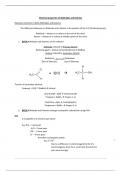
-
Chemical properties of Aldehydes and Ketones
- Exam (elaborations) • 45 pages • 2024
-
- $12.49
- + learn more
Chemical properties of Aldehydes and Ketones Reactions common to both Aldehydes and Ketones The difference between an Aldehyde and a Ketone is the position of the C=O (Carbonyl group). Aldehyde – always on a carbon at the end of the chain Ketone – Always on a carbon at middle carbon of the chain 1. BOTH Aldehydes and Ketones can be reduced Aldehyde reduced to Primary Alcohol Reducing agent = Sodium tetrahydroborate III (NaBH4) Ketone reduced to Secondary Alcohol Reduction Oxidisatio...
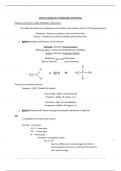
-
Chemical properties of Aldehydes and Ketones
- Exam (elaborations) • 45 pages • 2024
-
- $17.99
- + learn more
Chemical properties of Aldehydes and Ketones Reactions common to both Aldehydes and Ketones The difference between an Aldehyde and a Ketone is the position of the C=O (Carbonyl group). Aldehyde – always on a carbon at the end of the chain Ketone – Always on a carbon at middle carbon of the chain 1. BOTH Aldehydes and Ketones can be reduced Aldehyde reduced to Primary Alcohol Reducing agent = Sodium tetrahydroborate III (NaBH4) Ketone reduced to Secondary Alcohol Reduction Oxidisatio...
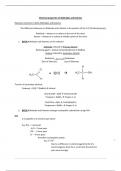
-
Chemical properties of Aldehydes and Ketones Reactions common to both Aldehydes and Ketones
- Exam (elaborations) • 45 pages • 2024
-
- $11.49
- + learn more
Chemical properties of Aldehydes and Ketones Reactions common to both Aldehydes and Ketones The difference between an Aldehyde and a Ketone is the position of the C=O (Carbonyl group). Aldehyde – always on a carbon at the end of the chain Ketone – Always on a carbon at middle carbon of the chain 1. BOTH Aldehydes and Ketones can be reduced Aldehyde reduced to Primary Alcohol Reducing agent = Sodium tetrahydroborate III (NaBH4) Ketone reduced to Secondary Alcohol Reduction Oxidisatio...
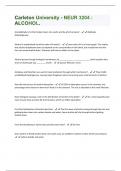
-
Carleton University - NEUR 3204 : ALCOHOL Questions And Answers Rated A+ 2024 Updates
- Exam (elaborations) • 3 pages • 2024
- Available in package deal
-
- $7.99
- + learn more
Acetaldehyde is further broken down into acetic acid by which enzyme? - Aldehyde dehydrogenase Alcohol is metabolized via which order of kinetics? - zero order, this is a linear graph. This implies that alcohol breakdown does not depend on the concentration in the blood, but instead how fast the liver can break alcohol down. Tolerance will have an effect on the slope. Alcohol passes through biological membranes via ____________ ______________, which explains why shots of alcohol get you __...
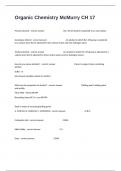
-
Organic Chemistry McMurry CH 17 Practice Exam Questions And Answers Guaranteed Pass.
- Exam (elaborations) • 6 pages • 2024
-
Available in package deal
-
- $12.99
- + learn more
Primary Alcohol - correct answer the -OH of alcohol is attached to an end carbon Secondary Alcohol - correct answer An alcohol in which the -OH group is attached to a carbon atom that is attached to two carbon chains and one hydrogen atom. Tertiary Alcohol - correct answer An alcohol in which the -OH group is attached to a carbon atom that is attached to three carbon atoms and no ...

-
Embalming Chemicals Questions And Answers 100% Verified.
- Exam (elaborations) • 7 pages • 2024
-
- $10.99
- + learn more
Embalming Chemicals Questions And Answers 100% Verified. Accessory Chemicals - correct answer. A group of chemicals used in addition to vascular and cavity embalming fluids; most are applied to the body; includes but is not limited to hardening compounds, preservative powders, sealing agents, mold preventative agents, and pack application agents. Active Dyes, Cosmetic Dyes, Staining Dyes - correct answer. Dyes which aid in restoring a life-like surface pigmentation ...
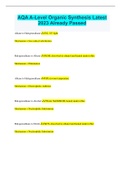
-
AQA A-Level Organic Synthesis Latest 2023 Already Passed
- Exam (elaborations) • 6 pages • 2023
-
Available in package deal
-
- $9.99
- + learn more
AQA A-Level Organic Synthesis Latest 2023 Already Passed Alkane to Halogenoalkane X2, UV light Mechanism = free radical substitution Halogenoalkane to Alkene KOH, dissolved in ethanol and heated under reflux Mechanism = Elimination Alkene to Halogenoalkane HX at room temperature Mechanism = Electropholic Addition Halogenoalkane to Alcohol Warm NaOH/KOH, heated under reflux Mechanism = Nucleophilic Substitution Halogenoalkane to Nitrile KCN, dissolved in ethanol and heated under reflux Mechan...

-
Depressants Practice Exam Questions And Correct Verified Answers.
- Exam (elaborations) • 6 pages • 2024
-
Available in package deal
-
- $13.49
- + learn more
How do CNS depressants act? - correct answer Decrease overall neuronal function CNS depressants medical treatment of what? - correct answer Benzodiazepines & barbiturates treat anxiety, insomnia, convulsions, muscle spasms What are benzodiazepines & barbiturates abused for? - correct answer Euphoric, sedative, & anxiolytic effects (decreased anxiety) ...

-
A-Level Chemistry 2024 Paper 2: Exam Questions with Complete solutions Merged
- Exam (elaborations) • 7 pages • 2024
- Available in package deal
-
- $7.99
- + learn more
Give an equation for the combustion of heptane (C7H16) in an excess of oxygen - Ans .C7H16 + 11O2 --> 7CO2 + 8H2O Heptane can be obtained from the catalytic cracking of hexadecane (C16H34) at a high temperature. Identify a suitable catalyst for this process.Give one condition other than high temperature.Give an equation for the catalytic cracking of one molecule of hexadecane to produce one molecule of heptane, one molecule of cyclohexane and one other product. - Ans .Zeolite OR alumi...

Do you wonder why so many students wear nice clothes, have money to spare and enjoy tons of free time? Well, they sell on Stuvia! Imagine your study notes being downloaded a dozen times for $15 each. Every. Single. Day. Discover all about earning on Stuvia


